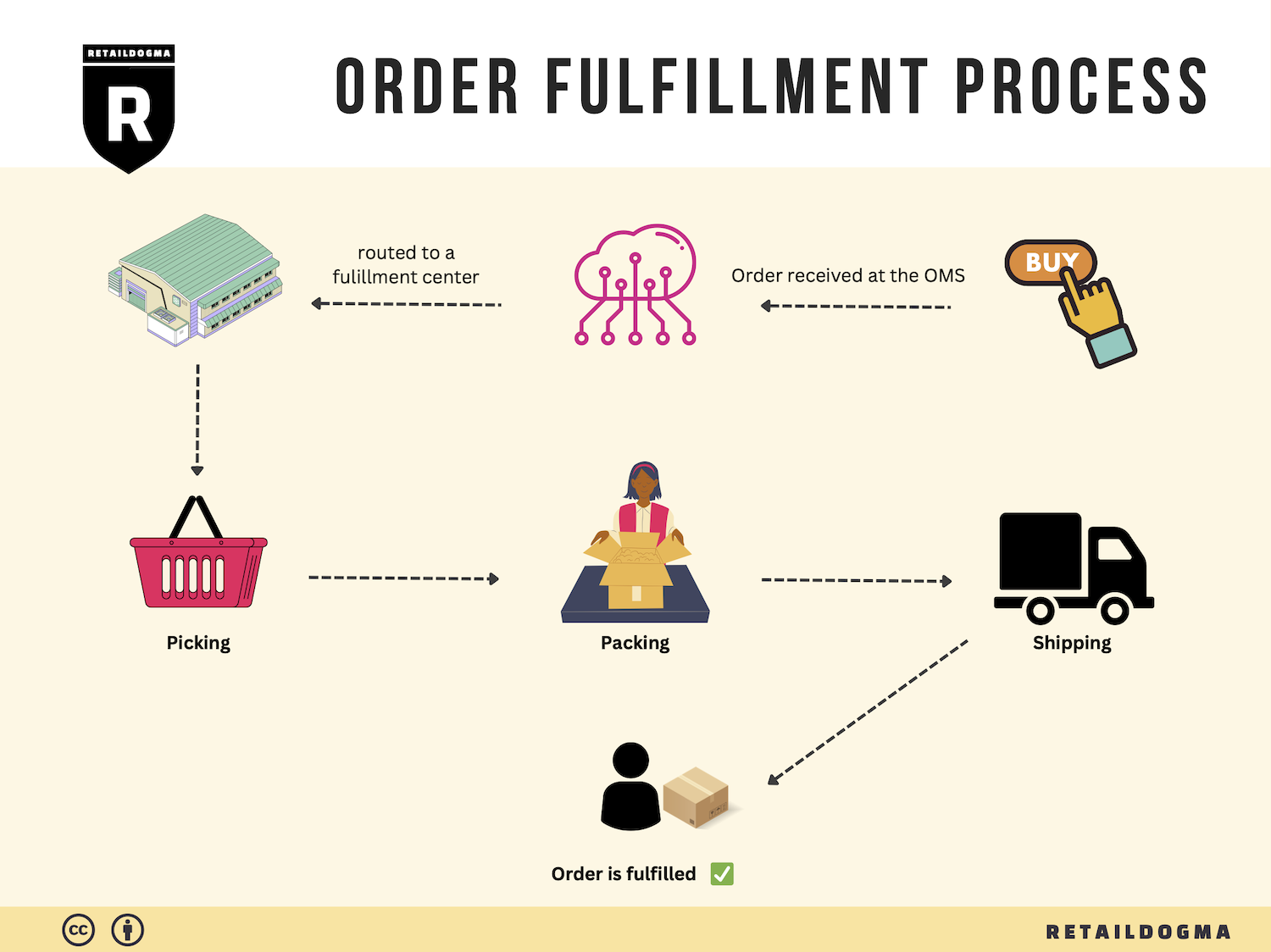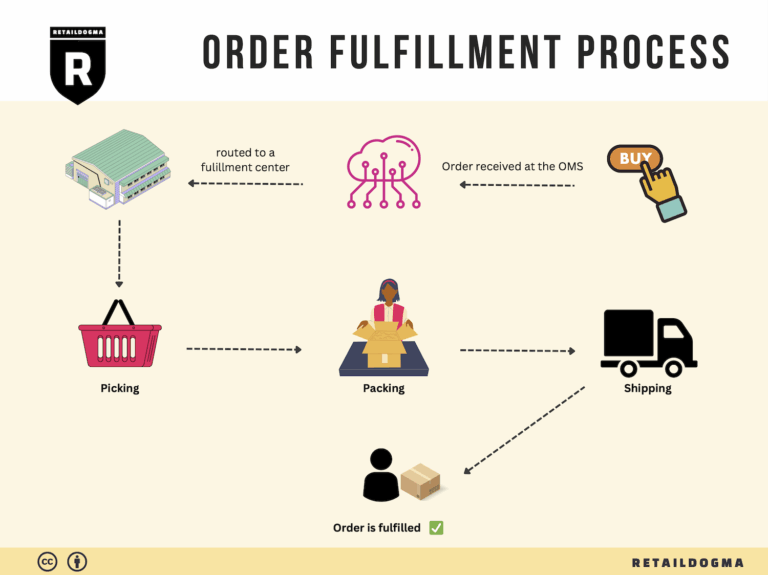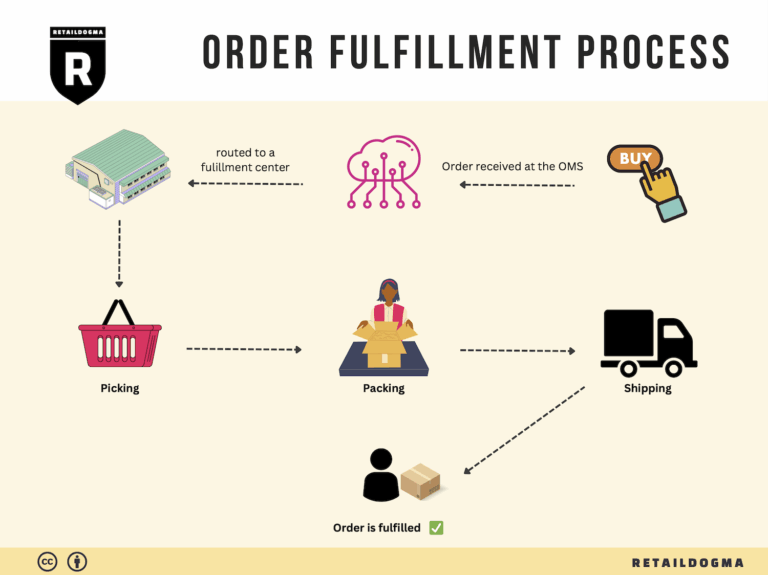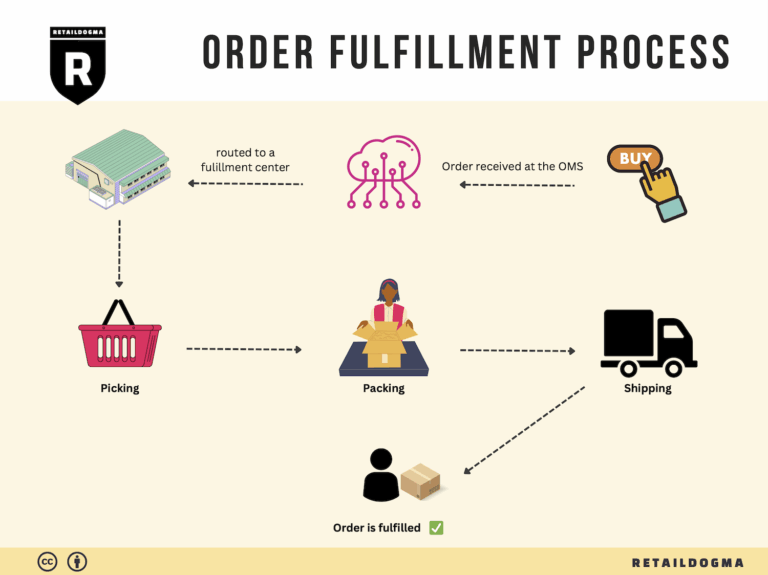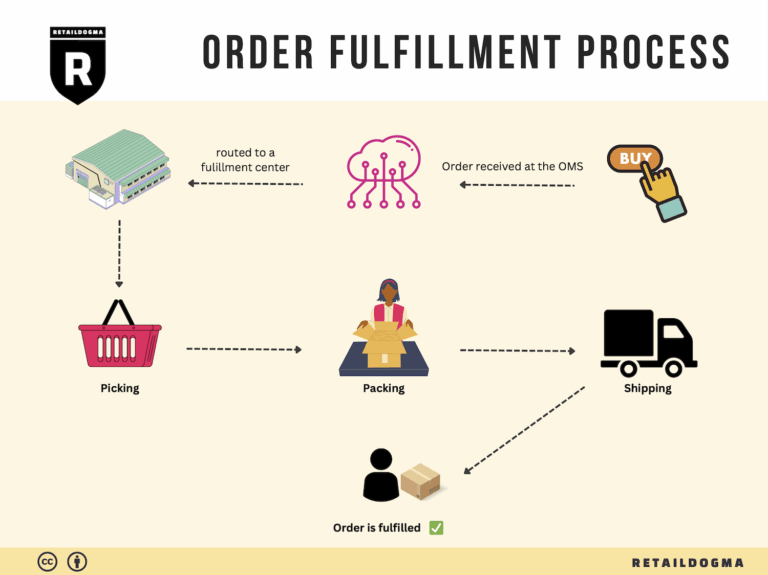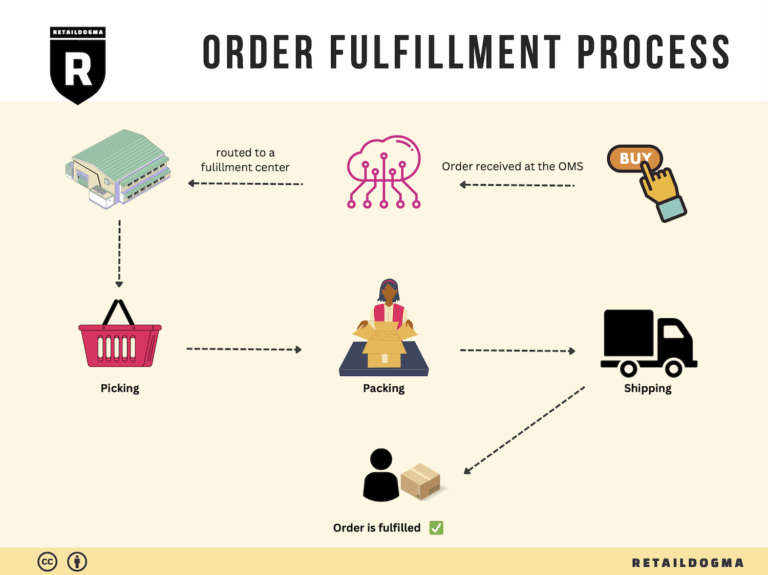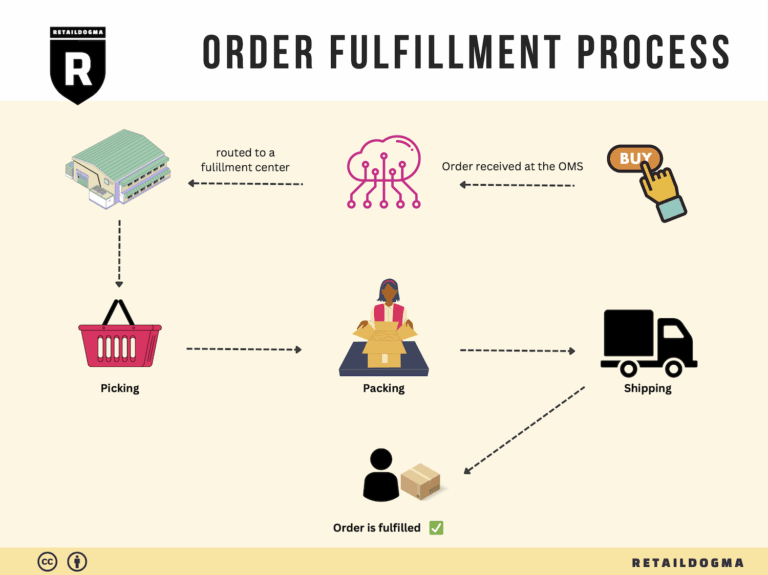What Is A Fulfillment Center? A Complete Guide (2025)
What is E-commerce Fulfillment? An Introduction for Growing Businesses
Understanding E-commerce Fulfillment: A Necessity for Growth
As an e-commerce business owner, you may often find yourself swamped with the tedious tasks of packing and shipping orders. This overwhelming responsibility can distract you from focusing on what truly matters: scaling your business. Fulfillment, in its simplest form, is the process of getting a product from your inventory into the hands of your customer. However, as your business grows, managing this process can become increasingly complex and time-consuming.
In today’s competitive landscape, efficient fulfillment is crucial to maintaining customer satisfaction and operational efficiency. This guide aims to demystify e-commerce fulfillment by exploring various models, including Fulfillment by Amazon (FBA) and third-party logistics (3PL). You’ll learn about the core services involved, how to select the right fulfillment partner for your unique needs, and the pricing structures that affect your bottom line.
What This Guide Covers
-
Fulfillment Models: Understand the differences between in-house fulfillment, FBA, and 3PL. Each model has its pros and cons, and the right choice depends on your business size, product type, and customer expectations.
-
Core Fulfillment Services: Discover essential services such as inventory management, order processing, shipping, and customer service. We’ll break down how these services can enhance your operational efficiency and customer experience.
-
Choosing a Fulfillment Partner: Selecting the right fulfillment partner is a critical decision that can either propel your business forward or hold it back. We’ll provide criteria to evaluate potential partners, ensuring you make an informed choice that aligns with your growth goals.
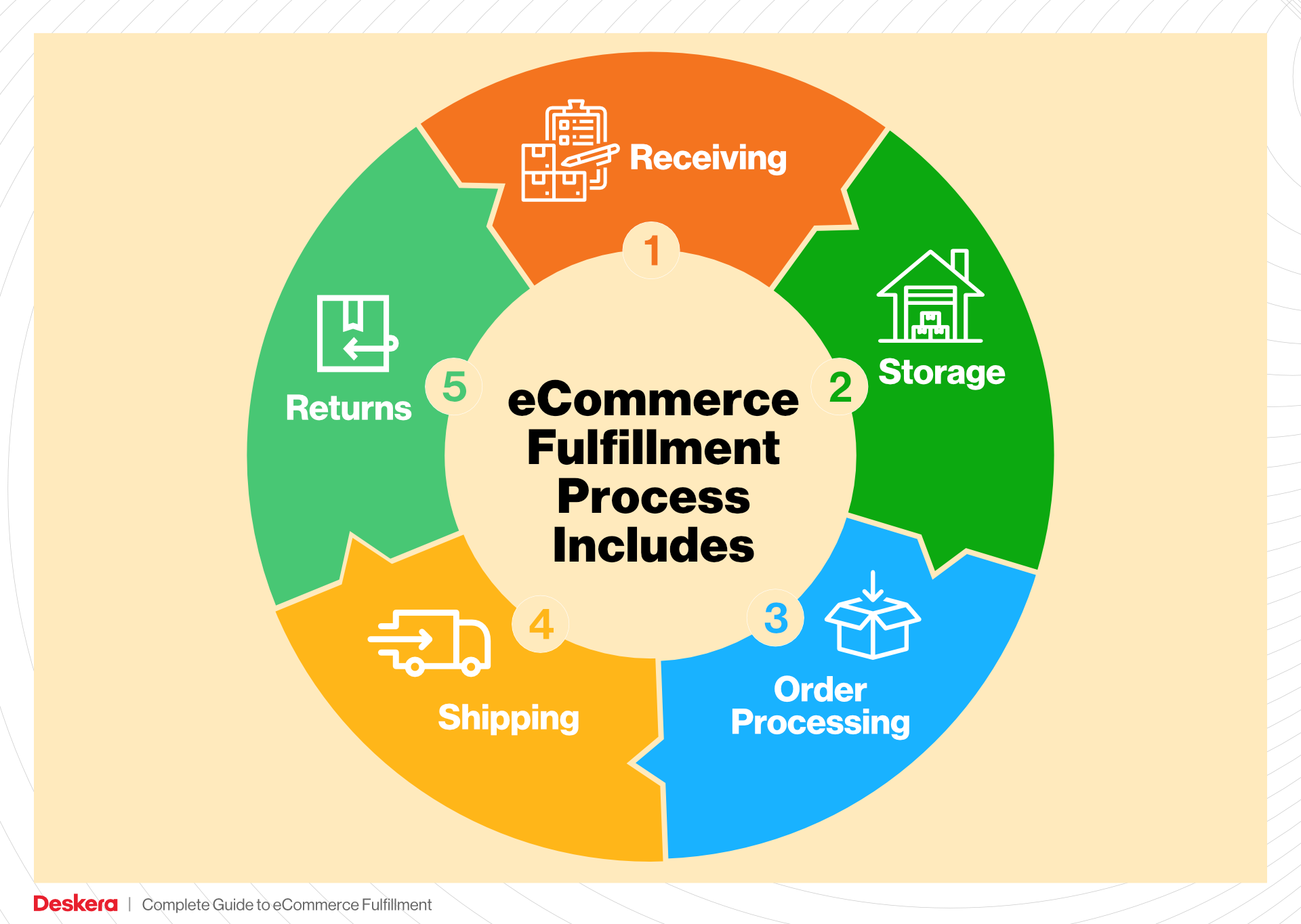
-
Pricing Considerations: Fulfillment costs can vary widely based on the model and partner you choose. We’ll provide insights into what to expect regarding fees, including storage, shipping, and handling costs, so you can budget effectively.
Empowering Your Logistics Decisions
The ultimate goal of this guide is to empower you—business owners, operations managers, and entrepreneurs—to make informed decisions about your logistics. By understanding the landscape of e-commerce fulfillment, you can streamline your operations, enhance customer satisfaction, and position your business for sustainable growth. Embrace the opportunity to transform your fulfillment process from a cumbersome task into a strategic advantage that drives your business forward.
What You’ll Learn In This Guide
- What is E-commerce Fulfillment? An Introduction for Growing Businesses
- The Order Fulfillment Process: From ‘Buy’ Button to Customer’s Door
- Comparing Fulfillment Models: In-House vs. 3PL vs. Dropshipping
- A Deep Dive into Amazon FBA: Pros, Cons, and Who It’s For
- Core Services Offered by Fulfillment Centers
- How to Choose a Fulfillment Partner: A 6-Point Checklist
- Understanding Fulfillment Pricing: A Breakdown of Common Fees
- Frequently Asked Questions (FAQs) about Fulfillment
- Conclusion: Is Outsourcing Fulfillment the Right Move for Your Business?
- Important Disclaimer
The Order Fulfillment Process: From ‘Buy’ Button to Customer’s Door
1. Receiving Inventory
The order fulfillment process begins with receiving inventory at an Amazon fulfillment center. When products arrive, they are checked for quality and quantity against the purchase order. This step is crucial because it ensures that the right items are received in the correct amounts, preventing discrepancies that could lead to stockouts or excess inventory.
A key term associated with this step is SKU (Stock Keeping Unit). Each product is assigned a unique SKU, which helps in tracking inventory and managing stock levels efficiently. Proper receiving processes also include labeling and categorizing items, which streamlines their subsequent storage and retrieval. This step sets the foundation for effective inventory management, allowing sellers to scale their operations without worrying about inaccuracies or delays.
2. Warehouse Storage
Once inventory is received, the next step is warehouse storage. Products are placed in designated storage areas within the fulfillment center based on their SKU, size, and demand. Efficient warehouse storage is vital for optimizing space and ensuring quick access to products when orders are placed.
The concept of bin locations is essential here. Each SKU is stored in a specific bin, which is part of a larger inventory management system. This organization allows for easy tracking and minimizes the time it takes to locate items during the picking process. Effective storage not only maximizes the use of space but also enhances the overall speed of order fulfillment, which is critical for meeting customer expectations, especially for Prime members who expect fast shipping.
3. Order Picking
When a customer clicks the ‘Buy’ button, the fulfillment process moves into order picking. This step involves selecting the correct items from the warehouse to fulfill the order. Amazon employs a sophisticated picking system that often utilizes pick lists, which outline the SKUs and quantities needed for each order.
Efficient order picking is crucial for maintaining order accuracy and speed. Amazon utilizes various picking strategies, such as single order picking, batch picking, and zone picking, depending on the volume of orders and the layout of the fulfillment center. By optimizing the picking process, sellers can fulfill orders quickly, reducing the time between purchase and delivery, which directly impacts customer satisfaction and retention.
4. Order Packing
Once the items are picked, they are moved to the packing station for preparation for shipment. Order packing involves carefully packing the products to prevent damage during transit and ensuring that the correct items are sent to the customer. This step is significant because it not only protects the merchandise but also enhances the unboxing experience for the customer.
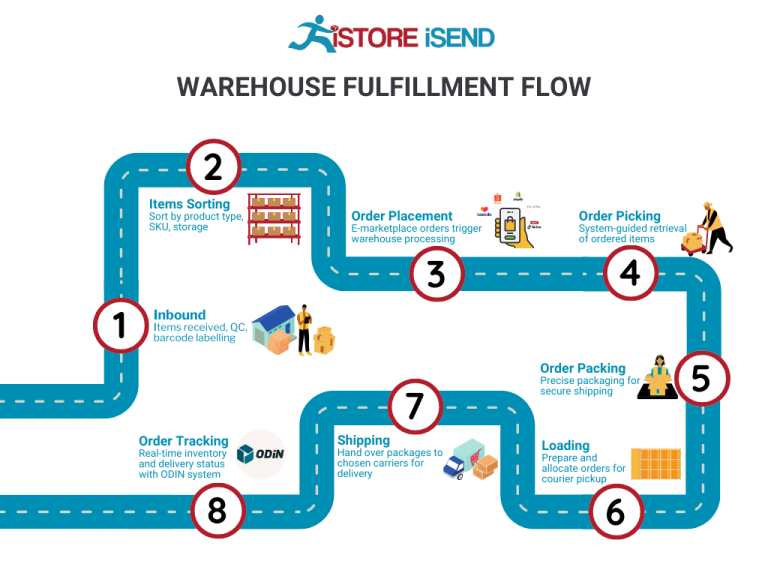
During this stage, packing slips are generated, which include order details and return instructions. The use of appropriate packing materials—such as bubble wrap, boxes, and tape—ensures that products arrive in good condition. Moreover, efficient packing processes can help minimize shipping costs by optimizing box sizes and weight. A well-executed packing process contributes to fewer returns and higher customer satisfaction, both of which are vital for a growing e-commerce business.
5. Shipping & Delivery
The final step in the order fulfillment process is shipping and delivery. Once an order is packed, it is handed over to a carrier for delivery. This step is crucial, as it directly influences the customer’s perception of the business. Timely and reliable shipping can lead to repeat purchases and positive reviews.
A key term in this stage is tracking number. Each shipment is assigned a tracking number, which allows customers to monitor their order’s progress in real-time. Amazon’s robust logistics network enables sellers to benefit from discounted shipping rates and expedited delivery options, such as two-day shipping for Prime members. Effective shipping strategies are essential for scaling an e-commerce business, as they can significantly enhance customer loyalty and drive sales growth.
In conclusion, the order fulfillment process is a multi-step operation that requires careful management at each stage—from receiving inventory to shipping and delivery. By understanding and optimizing these steps, e-commerce businesses can enhance operational efficiency, improve customer satisfaction, and ultimately scale their operations successfully.
Comparing Fulfillment Models: In-House vs. 3PL vs. Dropshipping
Comparing Fulfillment Models: Overview
When scaling an e-commerce business, selecting the right fulfillment model is critical to operational efficiency and customer satisfaction. Below is a comparison of three prevalent fulfillment models: In-House Fulfillment, Third-Party Logistics (3PL), and Dropshipping. Each model has its own strengths and weaknesses, making it essential for business owners to evaluate their unique needs and circumstances.
| Model | Who Handles Inventory | Best For (Business Stage) | Key Advantage | Key Disadvantage |
|---|---|---|---|---|
| In-House Fulfillment | The business itself | Established businesses with stable demand | Complete control over inventory and fulfillment process | High overhead costs and resource-intensive |
| Third-Party Logistics (3PL) | A third-party logistics provider | Growing businesses and startups | Scalability and access to expertise | Less control over the fulfillment process |
| Dropshipping | Suppliers or manufacturers | Startups and businesses testing products | Low upfront investment and minimal risk | Lower margins and potential quality control issues |
In-House Fulfillment
In-house fulfillment involves managing the entire logistics process within the business itself. This includes sourcing products, storing inventory, packing orders, and shipping them to customers. This model is most suitable for established businesses with a stable demand for their products.
Key Advantages:
The primary advantage of in-house fulfillment is the level of control it offers. Businesses can oversee every aspect of the fulfillment process, ensuring that quality standards are met and that inventory is managed efficiently. This model also allows for flexibility in operations, enabling businesses to respond quickly to market changes or customer needs.
Key Disadvantages:
However, in-house fulfillment can be resource-intensive, requiring significant investment in warehousing, staffing, and technology. Businesses must manage overhead costs, which can become burdensome as they scale. Moreover, as order volume increases, the complexities of logistics can overwhelm smaller teams, leading to inefficiencies and potential errors.
Third-Party Logistics (3PL)
Third-party logistics (3PL) involves outsourcing logistics operations to a specialized provider. These companies handle various aspects of fulfillment, including warehousing, order processing, shipping, and sometimes even returns. This model is ideal for growing businesses and startups that want to focus on scaling without getting bogged down by logistics.
Key Advantages:
The primary advantage of 3PL is scalability. Businesses can easily adjust their logistics operations to match fluctuating demand without the need to invest in additional infrastructure. 3PL providers often have established relationships with shipping carriers, which can lead to reduced shipping costs and improved delivery times. Furthermore, they bring expertise in logistics management, which can enhance operational efficiency.
Key Disadvantages:
On the downside, outsourcing fulfillment means relinquishing some control over the logistics process. Businesses must trust their 3PL partner to uphold quality standards and meet customer expectations. Additionally, any issues with the 3PL provider, such as delays or inaccuracies, can directly impact the business’s reputation and customer satisfaction.
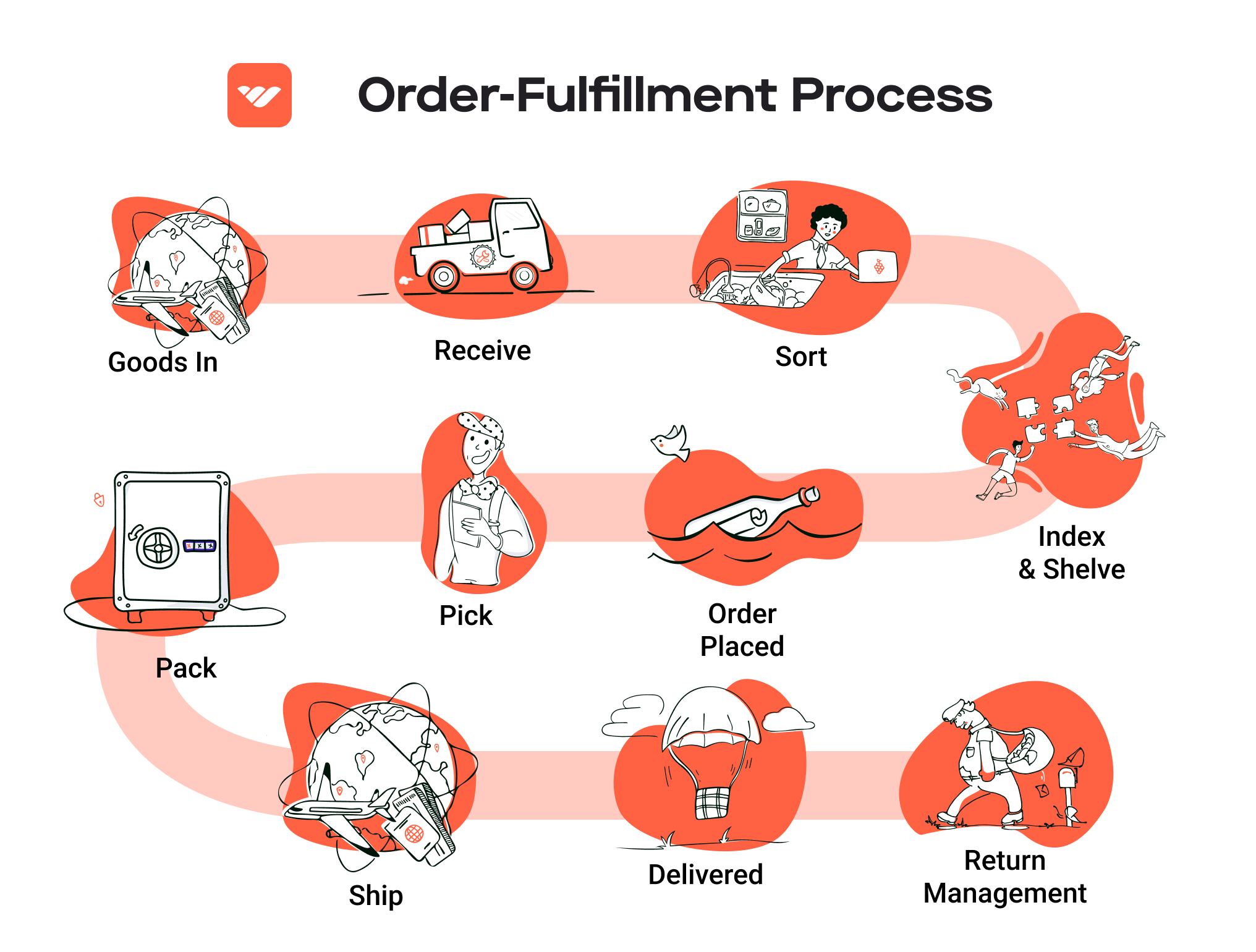
Dropshipping
Dropshipping is a fulfillment model where the retailer does not keep products in stock. Instead, when a customer places an order, the retailer purchases the item from a third-party supplier, who then ships it directly to the customer. This model is particularly popular among startups and businesses looking to test new products with minimal financial risk.
Key Advantages:
The most significant advantage of dropshipping is the low upfront investment required. Retailers do not need to purchase inventory upfront or manage storage facilities, which reduces financial risk. This model also allows businesses to offer a wide range of products without the constraints of inventory management. As a result, entrepreneurs can quickly pivot and respond to market trends.
Key Disadvantages:
However, dropshipping comes with its challenges. Retailers often face lower profit margins since they purchase products at a higher price from suppliers. Additionally, quality control can be an issue; since the retailer does not handle the products, they cannot guarantee the quality or timely delivery, which can lead to customer dissatisfaction. Lastly, reliance on suppliers for fulfillment can lead to delays and stock issues that are beyond the retailer’s control.
Conclusion
In summary, each fulfillment model presents unique benefits and challenges that can significantly impact an e-commerce business’s scalability and efficiency. In-house fulfillment offers control but comes with high overhead costs. 3PL provides scalability and expertise but requires trust in third-party partners. Dropshipping minimizes financial risk but may lead to lower profit margins and quality control issues. Business owners should carefully assess their operational needs, resources, and growth plans to choose the model that best aligns with their business goals.
A Deep Dive into Amazon FBA: Pros, Cons, and Who It’s For
What is Fulfillment by Amazon (FBA)?
Fulfillment by Amazon (FBA) is a logistics service provided by Amazon that allows e-commerce sellers to store their products in Amazon’s extensive network of fulfillment centers. When a customer places an order for a product listed through FBA, Amazon takes over the entire fulfillment process, which includes picking, packing, shipping, and handling customer service on behalf of the seller. This setup not only streamlines operations for sellers but also provides customers with the high-speed delivery and reliable service associated with the Amazon brand.
The process begins when a seller sends their inventory to Amazon’s fulfillment centers. Once the products are stored, they become eligible for Amazon’s Prime program, which provides customers with expedited shipping options. Additionally, sellers can benefit from Amazon’s established customer service and return handling, allowing them to focus on other aspects of their business.
How Does Amazon FBA Work?
-
Sign Up: Sellers must create an Amazon Seller account and enroll in the FBA program.
-
Prepare Inventory: Sellers prepare their products for shipment to Amazon, following specific guidelines for labeling and packaging.
-
Ship to Amazon: Once prepared, sellers send their inventory to designated Amazon fulfillment centers.
-
Product Listing: Sellers create product listings on Amazon, indicating that the items are fulfilled by Amazon.
-
Order Fulfillment: When a customer orders a product, Amazon takes care of the entire fulfillment process, including picking, packing, and shipping the product.
-
Customer Service: Amazon handles customer inquiries, returns, and refunds, providing a seamless experience for both sellers and customers.
-
Payment: After the sale, sellers receive payment from Amazon, minus applicable fees.
Pros of Amazon FBA
-
Prime Eligibility: Products fulfilled by Amazon are automatically eligible for Amazon Prime, which is a significant advantage. Prime members are more likely to purchase items that offer free two-day shipping, increasing sales potential for FBA sellers.
-
Customer Trust: Associating products with the Amazon brand instills confidence in consumers. Buyers often prefer purchasing from sellers using FBA because they trust Amazon’s fulfillment and customer service capabilities.
-
Multi-Channel Fulfillment: FBA allows sellers to fulfill orders from other sales channels (e.g., their own website, eBay) using Amazon’s logistics. This means sellers can centralize their inventory management and leverage Amazon’s shipping efficiencies.
-
Scalability: By outsourcing storage and fulfillment to Amazon, sellers can focus on growing their business rather than managing logistics. This is particularly beneficial for businesses looking to scale quickly without significant investment in infrastructure.
-
Reduced Shipping Costs: Amazon’s established relationships with shipping carriers allow FBA sellers to benefit from lower shipping rates, which can enhance profitability.
Cons of Amazon FBA
-
High Fees: While FBA simplifies logistics, it comes at a cost. Sellers incur various fees, including storage fees, fulfillment fees, and potential long-term storage fees. These costs can eat into profit margins, especially for low-priced items.
-
Strict Inventory Rules: Amazon has stringent guidelines regarding inventory management, including how products must be packaged and labeled. Non-compliance can lead to additional fees or even inventory being returned to the seller.
-
Commingling Risks: When products are stored in Amazon fulfillment centers, they may be commingled with inventory from other sellers. This can create issues, particularly if counterfeit or defective products enter the supply chain, potentially damaging a seller’s reputation.
-
Limited Control: Sellers relinquish a degree of control over the fulfillment process. Issues such as mismanagement of inventory, shipping delays, or customer service problems can arise, and sellers may have limited recourse.
-
Sales Tax Complications: Storing inventory in Amazon fulfillment centers can create sales tax nexus in various states, obligating sellers to comply with local tax laws. This adds a layer of complexity to financial management.
Who is FBA Best For?
Fulfillment by Amazon is particularly advantageous for:
-
Growing E-Commerce Businesses: Businesses that have reached a point where they need to scale operations but lack the infrastructure to do so can benefit greatly from FBA.
-
Sellers with High Sales Volume: Those who sell fast-moving products can leverage Amazon’s logistics to maximize efficiency and meet customer demand.
-
Entrepreneurs Focused on Brand Building: Sellers looking to build trust and credibility can benefit from the Amazon brand association, especially if they are new to the market.
-
Multi-Channel Sellers: Businesses that sell across various platforms can streamline their operations by using FBA for fulfillment, allowing them to focus on sales and marketing.
-
Sellers of Non-Seasonal Products: FBA works best for items with consistent demand. Sellers of seasonal products may find the costs associated with storage during off-peak periods prohibitive.
In conclusion, Fulfillment by Amazon offers a powerful solution for e-commerce sellers looking to streamline their operations and scale their businesses. However, it’s essential to weigh the benefits against the potential downsides, particularly concerning fees and control over inventory management. By understanding the pros and cons, sellers can make informed decisions about whether FBA is the right fit for their operations.
Core Services Offered by Fulfillment Centers
Inventory Management & Warehousing
Inventory management and warehousing are foundational services provided by fulfillment centers. These facilities offer dedicated space for e-commerce businesses to store their products, which can significantly reduce the logistical headaches associated with maintaining an in-house storage solution.
What It Is:
Fulfillment centers manage the storage, organization, and tracking of inventory. They utilize advanced software systems to monitor stock levels in real time, ensuring that businesses have a clear understanding of what products are available and when to reorder.
Benefits:
1. Scalability: As an e-commerce business grows, so does its inventory. Fulfillment centers provide the flexibility to scale storage space without the need for significant capital investment in real estate or additional staff.
2. Reduced Overhead Costs: Storing products in a fulfillment center eliminates the need for businesses to maintain their own warehouses, which can involve rent, utilities, and staff costs.
3. Improved Inventory Accuracy: With automated tracking and management systems, fulfillment centers can reduce errors associated with manual inventory counts, thereby minimizing stockouts and overstock situations.
Pick and Pack Services
Pick and pack services are critical for ensuring that customer orders are fulfilled accurately and efficiently. This process involves selecting items from the warehouse shelves and preparing them for shipment.
What It Is:
When an order is placed, fulfillment center staff (or automated systems) “pick” the products from storage and then “pack” them into shipping boxes. This service often includes labeling, sealing, and preparing the package for shipment.
Benefits:
1. Efficiency in Order Fulfillment: Fulfillment centers employ streamlined processes and technology to quickly pick and pack orders, which can significantly reduce delivery times. This is especially crucial for businesses that compete on speed.
2. Cost-Effectiveness: By outsourcing pick and pack services, businesses can avoid the costs associated with hiring, training, and managing their own fulfillment staff.
3. Enhanced Customer Experience: Fast and accurate order fulfillment can lead to higher customer satisfaction and repeat business. When customers receive their orders promptly and accurately, it enhances their overall shopping experience.
Kitting and Assembly
Kitting and assembly are value-added services that allow e-commerce businesses to offer more complex products without the logistical burden of assembling items themselves.
What It Is:
Kitting involves bundling multiple products into a single package, while assembly refers to putting together components to create a finished product. Fulfillment centers can handle both processes, ensuring that businesses can offer a variety of product configurations.
Benefits:
1. Increased Product Offerings: By utilizing kitting and assembly services, businesses can expand their product line without investing in additional labor or facilities. This flexibility allows for seasonal promotions or new product launches without significant risk.
2. Simplified Operations: Outsourcing these tasks allows businesses to focus on core competencies like marketing and customer service, rather than the logistics of assembly and packaging.
3. Cost Savings: Kitting and assembly can reduce shipping costs by consolidating multiple items into one package, thereby lowering overall freight expenses.
Returns Management (Reverse Logistics)
Returns management, or reverse logistics, is an essential service for e-commerce businesses that want to maintain a positive customer experience even when orders are returned.
What It Is:
This service encompasses the processes involved in handling returned products, including inspection, restocking, and refurbishment. Fulfillment centers often have dedicated systems to manage returns efficiently.
Benefits:
1. Streamlined Returns Process: A well-managed returns process helps minimize the hassle for both the business and its customers. Fulfillment centers can provide return shipping labels, process returns quickly, and restock items as needed.
2. Data Insights: By analyzing return data, businesses can gain valuable insights into customer preferences and product performance, allowing them to make informed decisions about inventory and product offerings.
3. Enhanced Customer Trust: A hassle-free returns process can significantly improve customer satisfaction and loyalty. Customers are more likely to purchase from a business that offers easy returns, knowing they have recourse if the product does not meet their expectations.
In conclusion, partnering with a fulfillment center allows e-commerce businesses to leverage specialized services that enhance operational efficiency, reduce costs, and improve customer satisfaction. By utilizing these core services, businesses can focus on growth and scaling, knowing that their logistics are in capable hands.
How to Choose a Fulfillment Partner: A 6-Point Checklist
Location & Warehouse Network
Why It’s Important:
The geographic location of your fulfillment partner’s warehouses can significantly impact shipping times and costs. A partner with a well-distributed network can help you reach your customers faster and reduce shipping expenses, especially if they have warehouses near major urban areas or your target market.
Questions to Ask:
– Where are your warehouses located, and how does that align with my customer base?
– How do you determine which warehouse will fulfill an order?
– Do you have a strategy for expanding your warehouse network as my business grows?
Technology & Integrations
Why It’s Important:
In today’s e-commerce environment, seamless technology integration is crucial for efficient operations. Your fulfillment partner should be able to integrate with your e-commerce platform, inventory management systems, and other tools to ensure real-time data exchange and visibility.
Questions to Ask:
– What technology platforms do you use for order management and tracking?
– Can you integrate with my existing e-commerce system (e.g., Shopify, Magento)?
– Do you offer an API for custom integrations?
– How do you handle inventory management and updates?
Specializations (e.g., Cold Storage, Oversized Items)
Why It’s Important:
Depending on your product type, you may need a fulfillment partner that specializes in certain areas, such as cold storage for perishables or handling oversized items. Choosing a partner with the right capabilities ensures that your products are stored and handled appropriately.
Questions to Ask:
– Do you have specialized facilities for my type of products (e.g., temperature control, fragile items)?
– What is your experience in handling my product category?
– Can you provide case studies or references from similar businesses?
Scalability & Capacity
Why It’s Important:
As your business grows, so will your fulfillment needs. A good partner should be able to scale with you, accommodating seasonal spikes in demand or long-term growth without compromising service quality.
Questions to Ask:
– What is your current capacity, and how do you handle overflow during peak seasons?
– What are your plans for scaling operations in the future?
– How quickly can you accommodate an increase in order volume?
Pricing and Contracts
Why It’s Important:
Understanding pricing structures and contract terms is essential to avoid unexpected costs that can erode your margins. Look for transparency in pricing and flexibility in contract terms to accommodate your business’s changing needs.
Questions to Ask:
– What are your pricing models (e.g., per order, per item, monthly fees)?
– Are there additional fees for services like returns processing or storage?
– What is the length of the contract, and what are the termination conditions?
– Can you provide a detailed breakdown of all potential costs?
Customer Support & Reviews
Why It’s Important:
Reliable customer support is critical for resolving issues quickly and maintaining operational efficiency. Additionally, reviews and testimonials from other clients can provide insight into the partner’s reliability and service quality.
Questions to Ask:
– What support channels do you offer (e.g., phone, email, chat)?
– What are your average response times for customer inquiries?
– Can you share references or case studies from other clients?
– How do you handle disputes or issues with orders?
Conclusion
Choosing the right fulfillment partner is a vital decision that can impact your e-commerce business’s efficiency, customer satisfaction, and overall growth potential. By utilizing this checklist, you can assess potential partners against critical criteria, ensuring that you find a provider that aligns with your operational needs and business goals. Make sure to conduct thorough due diligence, ask the right questions, and consider conducting a trial period before fully committing to a partnership. This strategic approach will help you build a robust fulfillment strategy that supports your business as it scales.
Understanding Fulfillment Pricing: A Breakdown of Common Fees
Initial Setup Fees
When starting with Fulfillment by Amazon (FBA), sellers may encounter initial setup fees. These costs are associated with creating your FBA account and preparing your products for fulfillment. The setup fee can vary based on the complexity of your inventory and the specific services you choose.
For instance, if your products require special labeling or preparation (such as poly-bagging or bubble wrapping), additional charges may apply. While the initial setup fee is often a one-time cost, it’s essential to factor it into your overall budget, as it can impact your cash flow in the early stages of your FBA journey.
Receiving Fees
Receiving fees are charged when Amazon accepts your inventory into their fulfillment centers. These fees cover the labor and resources needed to unload, inspect, and store your products.
Typically, receiving fees are calculated on a per-unit basis. For example, if you send 100 units of a product and the receiving fee is $0.30 per unit, your total receiving fee would be $30. It’s crucial to package your items appropriately to avoid additional charges due to damage or improper labeling upon arrival at the fulfillment center.
Storage Fees (per pallet/bin)
Storage fees apply to the space your inventory occupies within Amazon’s warehouses. These fees are calculated based on the volume of your products, typically measured in cubic feet.
Amazon charges monthly storage fees, which can vary depending on the time of year. For instance, standard monthly storage fees may be lower during the off-peak season (January to September) and increase during peak season (October to December) when demand is higher. Additionally, long-term storage fees are assessed for items stored for more than 365 days, which can significantly impact your profitability if you carry slow-moving inventory.
To minimize storage fees, consider conducting regular inventory audits to identify and remove underperforming products.
Pick & Pack Fees (per item/order)
Pick and pack fees are among the most significant costs associated with FBA. These fees cover the process of selecting your products from Amazon’s shelves, packaging them for shipment, and preparing them for delivery to the customer.
The fee structure is generally based on the size and weight of the items. For instance, standard-size items may incur a lower fee compared to oversized items. A typical fee might be around $2.50 for a standard-sized item and higher for larger items. Understanding this fee structure is crucial for pricing your products competitively while ensuring your margins remain intact.
Shipping Fees
Shipping fees are another critical component of fulfillment pricing. When a customer orders your product, Amazon handles the shipping logistics, which can save you considerable time and effort.
The shipping fees are usually included in the overall fulfillment fee, but it’s essential to understand how these costs are calculated. Factors influencing shipping fees include the destination of the shipment, the size and weight of the package, and the shipping speed selected by the customer. Amazon’s extensive shipping network allows them to negotiate favorable rates with carriers, which can ultimately benefit you as a seller.
To manage shipping costs effectively, consider utilizing Amazon’s tools for forecasting demand and optimizing inventory levels across fulfillment centers.
Conclusion: Tips for Getting an Accurate Quote
To accurately assess your fulfillment costs with Amazon, consider the following tips:
-
Utilize Amazon’s Revenue Calculator: This tool allows you to input your product details and receive estimates of various fees, helping you to budget effectively.
-
Review Your Inventory Regularly: Conducting frequent audits of your inventory can help you identify slow-moving products that may incur additional storage fees.
-
Understand Your Product Dimensions and Weight: Accurate measurements will ensure that you are charged correctly for storage and shipping.
-
Factor in Seasonal Variations: Be aware of how fees may fluctuate during peak seasons, and plan your inventory accordingly to avoid unexpected charges.
By understanding these common fulfillment pricing models, e-commerce business owners can make informed decisions that enhance profitability while leveraging Amazon’s extensive logistics capabilities.
Frequently Asked Questions (FAQs) about Fulfillment
1. What is Fulfillment by Amazon (FBA)?
Fulfillment by Amazon (FBA) is a service that allows e-commerce sellers to store their products in Amazon’s fulfillment centers. Amazon takes care of storage, packing, shipping, and customer service for these products, enabling sellers to focus on growing their business rather than logistics.
2. How does Amazon FBA work?
When a seller enrolls in FBA, they send their inventory to Amazon’s fulfillment centers. When a customer orders a product, Amazon picks, packs, and ships it on behalf of the seller. Customers benefit from fast shipping options, including Amazon Prime, while sellers gain access to Amazon’s vast infrastructure and customer base.
3. What are the benefits of using Amazon FBA?
FBA offers several advantages, including:
– Access to Prime Customers: Sellers can reach millions of Amazon Prime members.
– Customer Service Management: Amazon handles customer inquiries, returns, and refunds.
– Reduced Shipping Costs: Sellers benefit from Amazon’s shipping rates.
– Scalability: Sellers can grow their inventory without the need for additional storage space or staff.
4. What are the costs associated with Amazon FBA?
Costs include:
– Fulfillment Fees: Charged per unit for picking, packing, and shipping.
– Storage Fees: Monthly fees for storing products in Amazon’s warehouses.
– Long-Term Storage Fees: Additional fees for items stored over 365 days.
– Returns Processing Fees: Charges for processing returns.
5. What’s the difference between a warehouse and a fulfillment center?
A warehouse is primarily a storage facility where goods are kept until they are needed. In contrast, a fulfillment center not only stores products but also handles the logistics of picking, packing, and shipping orders directly to customers. Fulfillment centers are designed to facilitate quick order processing and shipping.
6. What is a 3PL (Third-Party Logistics)?
A 3PL provider offers outsourced logistics services, including warehousing, inventory management, and order fulfillment. While FBA is a specific service provided by Amazon, a 3PL can offer similar services across various platforms, allowing sellers more flexibility in managing their logistics.
7. How does FBA affect sales tax obligations?
Storing inventory in Amazon’s fulfillment centers can create a sales tax nexus, meaning sellers may need to collect sales tax in states where their inventory is stored. However, Amazon collects sales tax on behalf of sellers for orders placed through its marketplace, simplifying compliance for many sellers.
8. Can I use FBA for products sold outside of Amazon?
Yes, sellers can utilize FBA to fulfill orders from other sales channels, such as their own website. However, they must ensure that their inventory levels are accurately managed across all platforms to avoid stockouts or overstock situations.
9. What types of products are eligible for FBA?
Most physical products are eligible for FBA, but there are some restrictions. Items must comply with Amazon’s policies, which prohibit certain categories like hazardous materials or products that require special handling. Always check Amazon’s guidelines for specific eligibility criteria.
10. How do I get started with Amazon FBA?
To start with FBA, create an Amazon Seller account, sign up for FBA, and prepare your products according to Amazon’s guidelines. Once your inventory is sent to an Amazon fulfillment center, you can begin selling, and Amazon will handle the logistics for you.
Conclusion: Is Outsourcing Fulfillment the Right Move for Your Business?
Evaluating the Benefits of Outsourcing Fulfillment
Outsourcing fulfillment can be a transformative decision for e-commerce businesses, particularly those looking to scale operations effectively. By leveraging a fulfillment service like Fulfillment by Amazon (FBA), sellers can save significant time and resources. This allows you to focus on core business activities such as product development and marketing instead of getting bogged down in logistics.
One of the primary advantages of using a fulfillment service is the scalability it offers. As demand for your products grows, fulfillment partners can accommodate fluctuations in order volume without the need for substantial investments in storage and staff. This flexibility is crucial for businesses aiming to capitalize on seasonal trends or unexpected surges in sales.
Moreover, fulfillment services bring expertise to the table. With established systems for inventory management, shipping, and customer service, these partners can enhance your operational efficiency. They have the infrastructure to handle logistics effectively, ensuring that your customers receive their orders promptly and reliably. This not only improves customer satisfaction but also enhances your brand’s reputation.
However, it’s vital to choose the right fulfillment partner. Not all services are created equal, and selecting one that aligns with your business model and growth objectives is crucial for long-term success. Consider factors such as cost, service offerings, and the ability to integrate with your existing systems.
Next Steps
As you weigh the pros and cons of outsourcing fulfillment, take a moment to audit your current shipping and logistics processes. Are they hindering your growth? Could a fulfillment partner streamline your operations and improve customer experience? Assessing these questions will help you determine if outsourcing fulfillment is the right next step for your business. By strategically aligning your logistics with a capable partner, you can unlock new avenues for growth and efficiency.
Important Disclaimer
⚠️ Important Disclaimer
The information in this guide is for educational purposes. Fulfillment services, pricing, and platform features change frequently. Always conduct your own due diligence and consult with providers directly before making business decisions.
